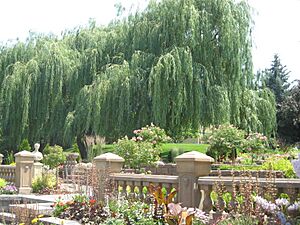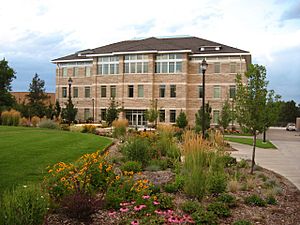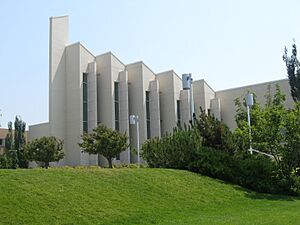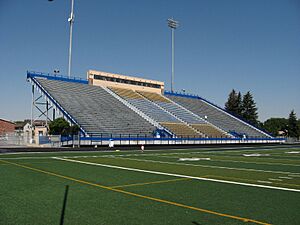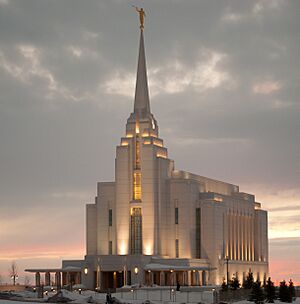Brigham Young University–Idaho facts for kids
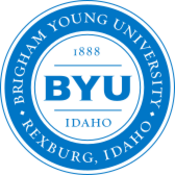 |
|
|
Former names
|
|
|---|---|
| Motto | Rethinking Education |
| Type | Private college |
| Established | November 12, 1888 |
|
Parent institution
|
Church Educational System |
| Accreditation | NWCCU |
|
Religious affiliation
|
The Church of Jesus Christ of Latter-day Saints |
|
Academic affiliations
|
Space-grant |
| President | Alvin F. Meredith III |
| Students | 45,584 (Fall 2024) |
| Location |
,
U.S.
43°49′05″N 111°47′06″W / 43.818°N 111.785°W |
| Campus | Rural |
| Newspaper | Scroll |
| Colors | Blue, black, white |
 |
|
Brigham Young University–Idaho (often called BYU–Idaho or BYUI) is a private college in the city of Rexburg, Idaho. It was founded in 1888 and is owned and run by The Church of Jesus Christ of Latter-day Saints (LDS Church).
For many years, the school was known as Ricks College and was a two-year junior college. In 2001, it changed to a four-year university that offers bachelor's degrees.
The university's main goal is to provide great education for undergraduate students (students working on their first college degree). BYU-Idaho offers over 100 different bachelor's degrees and more than 20 associate degrees.
It uses a special three-semester system called "tracks." This means students attend school for two semesters a year, which helps more students attend the university.
BYU-Idaho is part of the Church Educational System (CES), which includes other schools like Brigham Young University in Utah. Most students are members of the LDS Church and agree to follow an honor code, which is a set of rules for good behavior. Many students also take a break from school to serve as missionaries for the church.
Contents
History of the University
Early Academies
The school began on November 12, 1888, as the Bannock Stake Academy. Back then, there were not many public schools, so the LDS Church created "stake academies" to serve as high schools for settlers in the area.
As more people moved to the region, the area was divided. In 1898, the school was renamed the Fremont Stake Academy.
Ricks College
In 1903, the school's name changed again to Ricks Academy. It was named after Thomas E. Ricks, an early church leader in the area. Soon, public high schools became more common, so many church academies closed.
Ricks Academy survived by adding college-level classes. In 1923, it officially became Ricks College, a two-year junior college. For a short time between 1948 and 1956, it was a four-year school before returning to a junior college.
During the 1930s, the LDS Church considered giving the college to the state of Idaho, but the state said no. The church decided to keep the college open with the help of the local community.
In 1976, the nearby Teton Dam broke and caused a massive flood. Ricks College was used as a center to help people who were affected by the disaster. By the end of the 20th century, it was the largest private junior college in the United States.
Becoming BYU–Idaho
On June 21, 2000, the LDS Church announced that Ricks College would become a four-year university called Brigham Young University–Idaho. This change became official on August 10, 2001.
With this change, the school stopped having official sports teams that played against other colleges. Instead, it created a large program for students to play sports against each other on campus. The school also started its "three-track" semester system to allow more students to enroll.
Campus and Buildings
The BYU-Idaho campus is on a hill that looks over the city of Rexburg. It covers over 400 acres and has nearly 40 main buildings.
The campus has many interesting places, including a planetarium, an arboretum (a garden of trees), and museums for geology and wildlife. The David O. McKay Library has over 300,000 books for students to use.
For arts and music, the campus has a large concert hall with a famous Ruffatti pipe organ. The school also has a public radio station, KBYI-FM, that broadcasts from campus.
In 2010, the BYU–Idaho Center opened. This huge building has an auditorium that can seat 15,000 people for weekly meetings, graduation, and concerts. It also has a large gym area with 10 basketball courts.
How the University is Organized
BYU-Idaho is led by a president, Alvin F. Meredith III, who started in 2023. The university is guided by a Board of Trustees, which includes leaders from the LDS Church.
The university is divided into six smaller colleges:
- College of Agriculture and Life Sciences
- College of Business and Communication
- College of Education and Human Development
- College of Language and Letters
- College of Performing and Visual Arts
- College of Physical Sciences and Engineering
Academics and Learning
| Forbes | 324 |
|---|---|
BYU-Idaho offers both two-year associate degrees and four-year bachelor's degrees. The school is known for its strong engineering programs.
The school year is split into three equal semesters: Fall, Winter, and Spring. This is called the "three-track" system. When students are accepted, they are assigned to attend two of the three semesters each year. This helps keep the campus full year-round.
As of 2024, over 41,000 students were enrolled at BYU-Idaho, including students on campus and those taking online classes. Students come from all 50 states and over 130 countries. Most students are members of the LDS Church.
Athletics and Activities
The Ricks College Vikings
When the school was Ricks College, its sports teams were called the Vikings. From 1919 to 2002, they competed against other junior colleges and were very successful. The Vikings won 17 national championships in sports like cross country and volleyball.
Many athletes who played for Ricks College went on to play professional sports. However, when the school became BYU-Idaho, the official sports program was ended. This was done to focus on creating activities that all students could join.
Sports Today
BYU-Idaho no longer has teams that play against other universities. Instead, it has a large competitive sports program on campus. Students form teams and play against other student teams in sports like soccer, basketball, and flag football.
Student Life
A Unique Atmosphere
Life at BYU-Idaho is closely tied to the LDS Church. Every Tuesday, the school holds a "devotional," which is a worship service for students and staff. No classes are held during this time so everyone can attend.
The Rexburg Idaho Temple is located right next to the campus. Many students find it to be an important part of their experience at the university.
Campus Culture
The school tries to maintain the "Spirit of Ricks," which is a tradition of being friendly, hardworking, and helpful.
Because Rexburg is in a place with cold, snowy winters, sports like skiing and snowboarding are very popular. In the summer, students enjoy hiking, fishing, and camping. The campus is close to famous national parks like Grand Teton and Yellowstone.
The university's Student Activities program organizes many events for students, including dances, concerts, and service projects.
The Honor Code
All students and staff must agree to follow an Honor Code. This is a set of rules that encourages honesty, good language, and modest clothing. The Honor Code is part of the application process, and students promise to live by its standards.
Single students live in housing that is approved by the university. These apartments are all close to campus.
Famous Alumni
Over 200,000 people have graduated from BYU-Idaho and Ricks College. Famous alumni include:
- Rulon Gardner, a wrestler who won two Olympic medals.
- Marion G. Romney, who was a leader in the LDS Church.
- Ryan Hamilton, a popular comedian.
- Matt Lindstrom, a professional baseball player.



